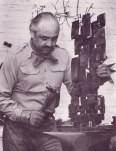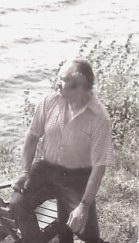
The Later Years
1970 - 1979
Not long after the move to Brussels, “Dickie” Goldschnmidt, a local banker and collector of Harold's sculptures, introduced him to the Belgian art circles. Within four months, Galerie Ad Libitum in Antwerp organized a major one-man show featuring the Gothics. The show was a huge success and most of the sculptures sold quickly.
The momentum from this event was such that Galerie Carefour, located in the heart of Brussels' upscale commercial district, offered Harold a contract for several more solo shows. At the first one, Hergé, the world acclaimed author-creator of the cartoon hero Tintin, purchased the Great Brussels Plaiton (1970).
1970 - 1979
Not long after the move to Brussels, “Dickie” Goldschnmidt, a local banker and collector of Harold's sculptures, introduced him to the Belgian art circles. Within four months, Galerie Ad Libitum in Antwerp organized a major one-man show featuring the Gothics. The show was a huge success and most of the sculptures sold quickly.
The momentum from this event was such that Galerie Carefour, located in the heart of Brussels' upscale commercial district, offered Harold a contract for several more solo shows. At the first one, Hergé, the world acclaimed author-creator of the cartoon hero Tintin, purchased the Great Brussels Plaiton (1970).

Soon thereafter, the Middleheim Museum in Antwerp acquired Osaka (1970), a major Plaiton work of monumental proportions, and another piece was sold to Belgium's Museum of Modern Art.
While the Gothics and other Plaitons were prevalent during this period, Harold developed a new style incorporating much fuller shapes, as reflected in Solid Elements (1969), Bloc Man, and Etudes en Masses et Tensions (1970). His return to more figurative work can be seen with La Mer du Nord (1969). Then, beginning with the Crucifixion (1970) and followed by Don Quichote (1973), the Human Comedy series of the `70s unfolded. The passion of earlier years slowly turns to the internal dilemma he perceived as inherent to the human condition with works such as the headless Maillot Jaune (Yellow Jersey), the contorted Buffoon, the distraught Grand Destin (Great Destiny), and the disembodied Maitre de Jeux (Puppet Master). All speak of the vibrant but searing pain that marked the final two decades of Harold's life.
While the Gothics and other Plaitons were prevalent during this period, Harold developed a new style incorporating much fuller shapes, as reflected in Solid Elements (1969), Bloc Man, and Etudes en Masses et Tensions (1970). His return to more figurative work can be seen with La Mer du Nord (1969). Then, beginning with the Crucifixion (1970) and followed by Don Quichote (1973), the Human Comedy series of the `70s unfolded. The passion of earlier years slowly turns to the internal dilemma he perceived as inherent to the human condition with works such as the headless Maillot Jaune (Yellow Jersey), the contorted Buffoon, the distraught Grand Destin (Great Destiny), and the disembodied Maitre de Jeux (Puppet Master). All speak of the vibrant but searing pain that marked the final two decades of Harold's life.

At the same time, almost as a parting farewell, he returned to combs and knots with pieces like the 1972 Witch's Comb, Witch's Knot, and Hanging Knot and introduced a red period toward the end of the decade with works in copper and steel. These works include Foret Cuivrée (Copper Forest - 1978), Vikking Warrior, and Vikking Flikka (1978), and red tinted steel with Bon Anniversaire (Happy Birthday - 1976).
Raymond Lacroix, another art collector and a personal friend of renown artist Renee Magritte's family, acquired several of Harold's sculptures and proudly displayed them next to the Margritte collection in his home. Impressed with Harold's work, he also organized a 1976 retrospective at the Maison de la Culture of Woluwe-St-Pierre, a commune of Brussels. The town soon after commissioned a large fountain for one of its town squares.
Raymond Lacroix, another art collector and a personal friend of renown artist Renee Magritte's family, acquired several of Harold's sculptures and proudly displayed them next to the Margritte collection in his home. Impressed with Harold's work, he also organized a 1976 retrospective at the Maison de la Culture of Woluwe-St-Pierre, a commune of Brussels. The town soon after commissioned a large fountain for one of its town squares.

1980 - 1992
From the mid-70s on, the pace of Harold's career, both in terms of exhibits and sculpture production, slowed due to his recurring bouts with ill health.
Interest in his work picked up again only after his death in 1992. During the 1980s, he showed about once a year. He ventured into a new arena by creating the set for a theater production of the Four Pennies Opera. Inexorably, he began to deal with life and health issues that slowly undermined his drive.
In the Spring of 1980, he developed oral cancer which he faught courageously until his death in 1992.
There may be a relation between the method he used to weld (oxygen-acetylene versus arc) and where the cancer developed. For years, long before this was known to science, he insisted that this was the way he chose to work and resisted the use of a protective mask. Until the last few years, he lived life to its fullest, driven by the vision that his art would transcend his mortality.
His studio, unattended for years, developed leaks in the roof which lead to regular flooding, resulting in rusting and water damage to many of his works. One year after his death, his children arranged to have the remaining sculptures crated and shipped to the U.S. where the Cousins now live.
From the mid-70s on, the pace of Harold's career, both in terms of exhibits and sculpture production, slowed due to his recurring bouts with ill health.
Interest in his work picked up again only after his death in 1992. During the 1980s, he showed about once a year. He ventured into a new arena by creating the set for a theater production of the Four Pennies Opera. Inexorably, he began to deal with life and health issues that slowly undermined his drive.
In the Spring of 1980, he developed oral cancer which he faught courageously until his death in 1992.
There may be a relation between the method he used to weld (oxygen-acetylene versus arc) and where the cancer developed. For years, long before this was known to science, he insisted that this was the way he chose to work and resisted the use of a protective mask. Until the last few years, he lived life to its fullest, driven by the vision that his art would transcend his mortality.
His studio, unattended for years, developed leaks in the roof which lead to regular flooding, resulting in rusting and water damage to many of his works. One year after his death, his children arranged to have the remaining sculptures crated and shipped to the U.S. where the Cousins now live.
1993 - Present
Since their arrival, many of the sculptures have been shown in the Washington, DC. area, including the Duke Ellington School for the Arts, where the Human Comedy works were on display from 1996 to 2003.
Impressed with the display, school founder Peggy Cooper Cafritz purchased several of his works for her private collection.
The Studio Museum in Harlem organized a traveling group exhibit entitled “Explorations in the City of Light: African-American Artists in Paris, 1945-1965”, which toured the U.S. with several important sculptures. They were exhibited at major museums in Chicago, New Orleans, Fort Worth, and Milwaukee.
The Michael Rosenfeld Gallery of New York showed several works in separate exhibitions between 1996 and 1999, culminating in a two-man show of Harold's sculptures and Beauford Delaney's paintings.
In 2000, the New York Metropolitan Museum of Art purchased Torso (1952).
In June 2000, the Neuberger Museum of Art, in Purchase, NY, included sculptures in an exhibit entitled “Welded Sculpture of the 20th Century”, which was commemorated in an illustrated book of the same name produced by the curator Judy Collischan.
The Brooklyn Museum of Art included works in an exhibition entitled “Vital Forms in America 1940 - 1960” and have expressed a desire to acquire a Cousins work for its permanent collection.
Cousins sculptures are starting to appear in the international auction marketplace, probably as a result of ownership transfers with the passing of original owners.
In our on-going effort to track the Cousins legacy, we hope this website will prompt any and all to provide us with current pictures of these works and inform us of their ultimate location.
Since their arrival, many of the sculptures have been shown in the Washington, DC. area, including the Duke Ellington School for the Arts, where the Human Comedy works were on display from 1996 to 2003.
Impressed with the display, school founder Peggy Cooper Cafritz purchased several of his works for her private collection.
The Studio Museum in Harlem organized a traveling group exhibit entitled “Explorations in the City of Light: African-American Artists in Paris, 1945-1965”, which toured the U.S. with several important sculptures. They were exhibited at major museums in Chicago, New Orleans, Fort Worth, and Milwaukee.
The Michael Rosenfeld Gallery of New York showed several works in separate exhibitions between 1996 and 1999, culminating in a two-man show of Harold's sculptures and Beauford Delaney's paintings.
In 2000, the New York Metropolitan Museum of Art purchased Torso (1952).
In June 2000, the Neuberger Museum of Art, in Purchase, NY, included sculptures in an exhibit entitled “Welded Sculpture of the 20th Century”, which was commemorated in an illustrated book of the same name produced by the curator Judy Collischan.
The Brooklyn Museum of Art included works in an exhibition entitled “Vital Forms in America 1940 - 1960” and have expressed a desire to acquire a Cousins work for its permanent collection.
Cousins sculptures are starting to appear in the international auction marketplace, probably as a result of ownership transfers with the passing of original owners.
In our on-going effort to track the Cousins legacy, we hope this website will prompt any and all to provide us with current pictures of these works and inform us of their ultimate location.

